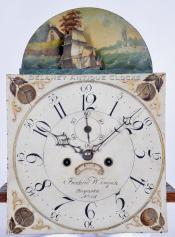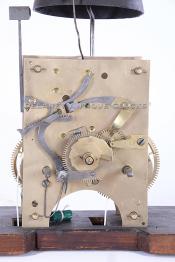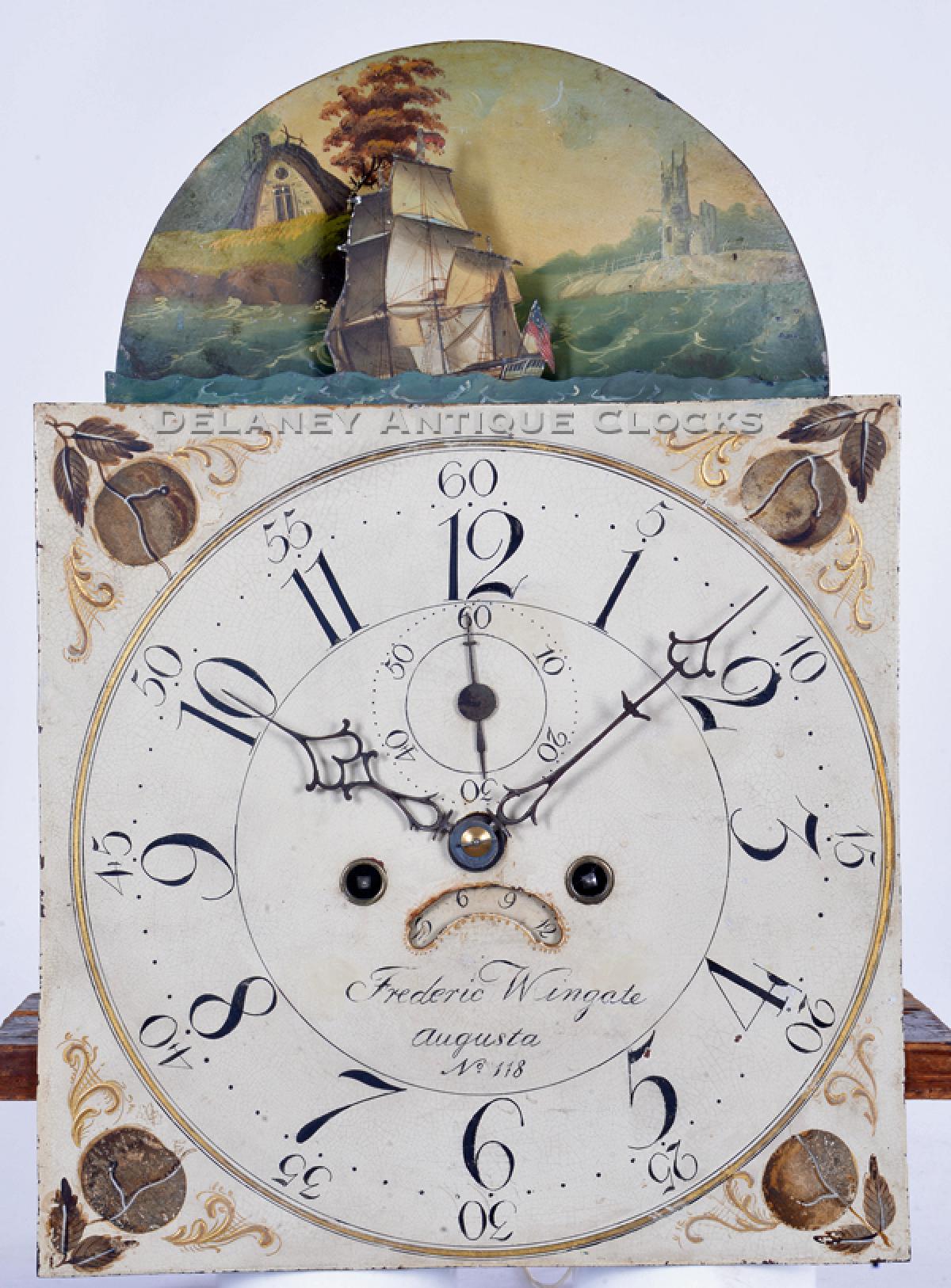Frederick Wingate of Augusta, Maine. A mahogany-cased tall clock that features a rocking ship dial. This dial is numbered 118. VV-134.
This is a well-proportioned, inlaid mahogany-cased tall clock. It was made by Frederick Wingate of Augusta, Maine, circa 1813. This is one of the most formal examples known, featuring a rocking ship dial and an inlaid case.
This is a very good example of this Augusta, Maine clockmaker's work. The case is primarily constructed in mahogany and features bird's-eye maple highlights and light line inlays. The secondary wood is New England white pine. This important example stands on cut-out bracket feet that retain excellent height. They are visually separated from the base section with a thinly applied molding. The base features an applied panel decorated with a line inlay around the panels' perimeter. The waist door is rectangular and is trimmed with a molded edge. This is also line inlaid and has the added decorative feature of inlay quarter fans in each of the four corners. The sides of the waist section are fitted with turned quarter columns. These are unusual in that they are constructed from a selection of bird's-eye maple. The grain pattern exhibited in this light-colored wood is very interesting. Both of these quarter columns terminate in brass quarter capitals. They are visually supported on veneered plinths. These plinths are also veneered in bird's-eye maple. The bonnet features a New England-style fretwork pattern. This is a pleasing design. Three-period brass finials are mounted on top of the bird's-eye maple finial plinths. The bonnet columns are smoothly turned and subtly shaped. They are free-standing and secured in brass capitals. The arched-shaped bonnet door is fitted with glass. This door opens to access the clock's dial.
This iron dial was paint-decorated by Spencer Nolen. Nolen was an ornamental artist, dial maker, and looking glass maker that worked in Boston and Philadelphia. This is an automated dial. Dials such as this are thought to have been purchased on special order at most certainly at additional cost. The automated feature of a rocking ship is located in the arch of this dial. The painted ship is depicted flying the American flag. When the clock is running, the ship moves or rocks gently from side to side with the motion of the pendulum. The painted scene behind the sailing ship is painted on iron. This iron plate is slightly curved to allow room for the ship to move and adds to the visual depth of the scene. This painted nautical seascape includes a large residence that sits atop a rocky-faced peninsula on the left. A stone building is on the point to the right. This dial also displays the hours, minutes, seconds, and calendar day. It is interesting to note that all of the numerals are in an Arabic format. A gilt ring frames the time ring. Apples are used as the decoration feature in each of the four corner or spandrel locations. The clockmaker signs this dial-in script lettering, "Frederic Wingate." This signature area also includes his working location, "Augusta," and is numbered "No. 118."
Behind the dial is a finely constructed brass movement that is considered good quality. Four-turned pillars support the two brass plates. Hardened steel shafts support the polished steel pinions and brass gearing. The winding drums are grooved. The escapement is designed in a recoil format. The movement is weight driven and designed to run for eight days on a full wind. It is a two-train or a time-and-strike design having a rack and snail striking system. As a result, it will strike each hour on the hour. This is done on a cast iron bell mounted above the movement.
This clock was made circa 1813.
This case is approximately 92.5 inches tall, 18.75 wide, and 9.75 inches deep.
It is inventory number VV-134.
Frederick Wingate, silversmith, watch, and clockmaker, was born in Haverhill, Massachusetts, on January 11th, 1782, and died in Augusta, Maine, on November 16th, 1864. His parents were William Wingate (1745-1821) and Mehitable (Bradley) Wingate (1747-1796). He had an older brother, Paine Wingate (1767-1833), who was working in Boston as a clockmaker as early as 1789. Paine may have trained Frederick. Frederick married Hannah Page of Haverhill on January 17th, 1806. In 1814, he served as a soldier during the War of 1812.
Frederick worked as a silversmith, watch, and clockmaker and became one of Maine's most prolific clockmakers. He may have been trained in Massachusetts before he moved north to Augusta, Maine, by 1803. As a clockmaker, he made many tall, banjo, and mirror clocks. Many of the tall clock dials are numbered. Our family has recorded examples from low as number 15 to a high of 302. Frederick trained Benjamin Swan to make clocks in 1808. Swan was from Augusta, and his clocks are often very similar in form. They share similar characteristics, such as the use of contrasting woods. Reoccurring features found on many Augusta clocks are the use of figured maple in the waist door and base panel, unusual turned and often shaped waist and hood columns, and Boston-painted dials painted by Spencer Nolen. A fair number of Wingate clocks retain their original setup labels. If present, these can be found pasted inside the waist door.










